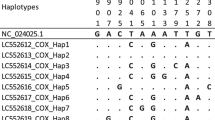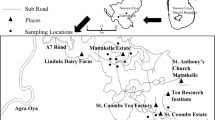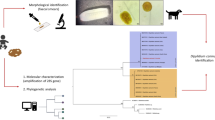Abstract
Dicrocoeliosis is a worldwide parasitic disease of ruminants which affects the liver. In this current study, the phylogenic pattern of Dicrocoelium species in Iranian native sheep from three different geographical regions was investigated by investigating a 520 bp fragment of mitochondirial NAD1 gene. The analysis of the NAD1 oligo nucleotide sequences from 10 D. dendriticum (GenBank accession numbers: MG889399 to MG889408) revealed few non-significant differences, suggesting limited application for NAD1 gene as a biomarker for study of genetic variation in Dicrocoelium. The morphometrical study also showed a significant relationship for the several morphometric indices among the Dicrocoelium spp. isolates from different regions of Iran.




Similar content being viewed by others
References
Ahmadi NA, Meshkehkar M (2010) Prevalence and long term trend of liver fluke infections in sheep, goats and cattle slaughtered in Khuzestan, southwestern Iran. J Paramed Sci 1(2):26–31
Ansari-Lari M, Moazzeni M (2006) A retrospective survey of liver fluke disease in livestock based on abattoir data in Shiraz, south of Iran. Prev Vet Med 73:93–96
Arbabi M, Dalimi-Asl A, Ghaffarifar F, Foorozandeh-Moghadam M (2012) Morphological and molecular characterization of Dicrocoelium isolated from sheep in the north and center of Iran. Feyz 16:135–145
Bazsalovicsová E, Králová-Hromadová I, Špakulová M, Reblánová M, Oberhauserová K (2010) Determination of ribosomal internal transcribed spacer 2 (ITS2) interspecific markers in Fasciola hepatica, Fascioloides magna, Dicrocoelium dendriticum and Paramphistomum cervi (Trematoda), parasites of wild and domestic ruminants. Helminthologia 47:76–82
Bian Q, Zhao G, Jia Y, Fang Y, Cheng W, Du S, Ma X, Lin Q (2015) Characterization of Dicrocoelium dendriticum isolates from small ruminants in Shaanxi Province, north-western China, using internal transcribed spacers of nuclear ribosomal DNA. J Helminthol 89:124–129
Daryani A, Alaei R, Arab R, Sharif M, Dehghan M, Ziaei H (2006) Prevalence of liver fluke infections in slaughtered animals in Ardabil province, Northwestern Iran. J Anim Vet Adv 5:408–411
Di G (2010) Liver fluke infections. In: Warrell DA, Cox TM, Firth JD (eds) Oxford textbook of medicine. Oxford University Press, New York, USA
Ferreras-Estrada MC, Campo R, González-Lanza C, Pérez V, García-Marín JF, Manga-González MY (2007) Immunohistochemical study of the local immune response in lambs experimentally infected with Dicrocoelium dendriticum (Digenea). Parasitol Res 101:547–555
Ghazani MHM, Valilou MR, Ahmadzadeh AR, Karami AR, Zirak K (2008) The prevalence of sheep liver trematodes in the northwest region of Iran. Turk J Vet Anim Sci 32:305–307
Gorjipoor S, Moazeni M, Sharifiyazdi H (2015) Characterization of Dicrocoelium dendriticum haplotypes from sheep and cattle in Iran based on the internal transcribed spacer 2 (ITS-2) and NADH dehydrogenase gene (nad1). J Helminthol 89:158–164
Herwerden L, Blair D, Agatsuma T (2000) Multiple lineages of the mitochondrial gene NADH dehydrogenase subunit 1 (nad1) in parasitic helminths: implications for molecular evolutionary studies of facultatively anaerobic eukaryotes. J Mol Evol 51:339–352
Hinaidy H (1983) Dicrocoelium suppereri nomen novum (syn. D. orientalis Sudarikov et Ryjikov 1951), ein neuer Trematode für die Parasitenfauna Österreichs. Zoonoses Publ Health 30:576–589
Karadag B, Bilici A, Doventas A, Kantarci F, Selcuk D, Dincer N, Oner YA, Erdincler DS (2005) An unusual case of biliary obstruction caused by Dicrocoelium dentriticum. Scand J Infect Dis 37:385–388
Manga-Gonzalez MY, Gonzalez-Lanza C, Del-Pozo-Carnero P (1991) Dynamics of the elimination of Dicrocoelium dendriticum (Trematoda, Digenea) eggs in the faeces of lambs and ewes in the Porma basin (Leon, NW Spain). Ann Parasitol Hum Comp 66:57–61
Manga-González MY, González-Lanza C, Cabanas E, Campo R (2001) Contributions to and review of dicrocoeliosis, with special reference to the intermediate hosts of Dicrocoelium dendriticum. Parasitology 123:91–114
Martínez-Ibeas A, Martínez-Valladares M, González-Lanza C, Miñambres B, Manga-González MY (2011) Detection of Dicrocoelium dendriticum larval stages in mollusc and ant intermediate hosts by PCR, using mitochondrial and ribosomal internal transcribed spacer (ITS-2) sequences. Parasitology 138:1916–1923
Moazeni M, Sharifiyazdi H, Izadpanah A (2012) Characterization of Fasciola hepatica genotypes from cattle and sheep in Iran using cytochrome C oxidase gene (CO1). Parasitol Res 110:2379–2384
Otranto D, Traversa D (2003) Dicrocoeliosis of ruminants: a little known fluke disease. Trends Parasitol 19:12–15
Otranto D, Rehbein S, Weigl S, Cantacessi C, Parisi A, Lia RP, Olson PD (2007) Morphological and molecular differentiation between Dicrocoelium dendriticum (Rudolphi, 1819) and Dicrocoeliumchinensis (Sudarikov and Ryjikov, 1951) Tang and Tang, 1978 (platyhelminthes: Digenea). Acta Trop 104:91–98
Rosick B, Groschaft J (1982) Dicrocoeliosis. In: Hillyer G, Hopla C (eds) CRC handbook series in zoonoses. Section C: Parasitic Zoonoses. CRC Press, Florida
Sandoval H, Manga-González Y, Campo R, Garcia P, Castro JMA, de la Vega MP (1999) Preliminary study on genetic variability of Dicrocoelium dendriticum determined by random amplified polymorphic DNA. Parasitol Int 48:21–26
Taira K, Shirasaka S, Taira N, Ando Y, Adachi Y (2006) Morphometry on lancet flukes found in Japanese sika deer (Cervus nippon centralis) captured in Iwate Prefecture, Japan. J Vet Med Sci 68:375–377
Tkach VV, Pawlowski J, Sharpilo VP (2000) Molecular and morphological differentiation between species of the Plagiorchis vespertilionis group (Digenea, Plagiorchiidae) occurring in European bats, with a re-description of P. vespertilionis (Müller, 1780). Syst Parasitol 47:9–22
Yamaguti S (1971) Synopsis of digenetic trematodes of vertebrates. Vols I and II. Keigaku Publishing Co, Tokyo
Author information
Authors and Affiliations
Corresponding author
Ethics declarations
Conflict of interest
The authors declare that there is no conflict of interest.
Ethical standards
This article is prepared and presented by the author in accordance with the ethical standards.
Additional information
Publisher's Note
Springer Nature remains neutral with regard to jurisdictional claims in published maps and institutional affiliations.
Rights and permissions
About this article
Cite this article
Shamsi, L., Tavassoli, M., Naem, S. et al. Morphologic and molecular analysis of Dicrocoelium dendriticum species from Iranian native sheep. J Parasit Dis 44, 441–446 (2020). https://doi.org/10.1007/s12639-020-01201-z
Received:
Accepted:
Published:
Issue Date:
DOI: https://doi.org/10.1007/s12639-020-01201-z




